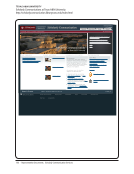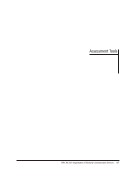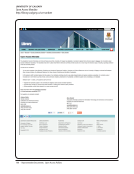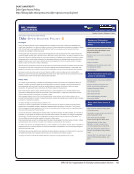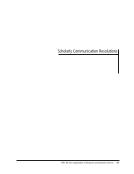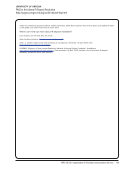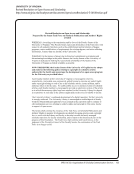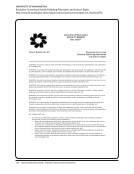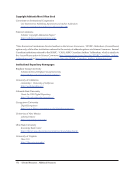18 · Survey Results: Executive Summary
member libraries were leading in 2007 (at that time,
75% of responding institutions stated that they were
engaged in SC education initiatives). Results from this
survey point to gains in staffing and spaces for SC,
indicating an institutional need and demand for these
services, and successful internal educational efforts,
since most respondents indicated that SC education
is a significant role for liaison librarians.
Furthermore, educational initiatives have likely
played a significant role in the rise of author activism.
In all the faculty governance statements about OA
or SC initiatives that survey respondents provided,
libraries were identified as partners in publishing,
rights negotiations, and education. Many of these
resolutions were passed between 2007 and 2009,
around the time that the National Institutes of Health
(NIH) Public Access Policy was implemented and
prior to the National Science Foundation’s require-
ment for data management plans. Many libraries were
involved in advising authors about NIH compliance
and may have taken it as an additional opportunity
to talk to faculty about open access and author rights.
Author activism may now be seen in a variety of out-
lets: faculty signing national petitions against the
high prices of subscriptions to scholarly publications,
individual departments adopting open access resolu-
tions, faculty refusing to publish or edit in particular
journals, and, as stated earlier, faculty founding and
editing their own journals hosted on library servers.
In part because of education and outreach efforts,
especially with regard to institutional repositories,
libraries have been acknowledged as relevant parties
in institutional planning for preserving and hosting
digital content. Past SC efforts that reached out to fac-
ulty and research groups have also prepared librar-
ians to be included in recent SC developments, not just
in the sciences, but also in the humanities. Overall,
collaboration among libraries and other institution-
al units to support SC activities is more prominent
and obvious than it was in 2007, as evidenced by the
partnerships identified by member libraries in their
survey responses. Additionally, with the advent of
digital humanities activities, humanities researchers
are more visible and vocal participants in a greater
number of SC activities than was the case in 2007.
Conclusion
Overwhelmingly, libraries are leaders in organizing
scholarly communication efforts at their institutions.
This leadership is highly collaborative. Within librar-
ies, leadership is often distributed among several li-
brary units, offices, or staff positions. In the larger
institutional setting, libraries have many partners
whose activities support and complement their SC
services, even though the various centers, units, and
groups involved do not use the SC label. Librarians’
roles as educators, liaisons, and digital preservation-
ists are well-established, but in the developing area
of digital research, including the digital humanities
and data management plans, libraries, like most in
the academic community, are still finding their way.
More assessment of the research community’s needs
could prove useful in discovering how library SC ser-
vices and leadership might be better marketed, further
developed, or differently arranged to address those
needs. In the coming years, as access to datasets, and
not just scholarly articles, becomes the norm due to
funding mandates and other legislation, the need to
develop and use alt-metrics to determine research
impact will become more apparent, and may lead to
changes in tenure review practices, such as focusing
on article-level metrics rather than journal impact
factors. As is still the case with open access, any new
developments will require information professionals
to become savvy users of these new systems, pro-
viding feedback to designers, and helping others in
the research community understand and apply these
features in their own projects. These are just a few of
the many changes occurring in the scholarly com-
munication landscape, where libraries seem poised to
continue organizing leadership, services, and support
that foster researchers’ activities and increase their
global reach.
member libraries were leading in 2007 (at that time,
75% of responding institutions stated that they were
engaged in SC education initiatives). Results from this
survey point to gains in staffing and spaces for SC,
indicating an institutional need and demand for these
services, and successful internal educational efforts,
since most respondents indicated that SC education
is a significant role for liaison librarians.
Furthermore, educational initiatives have likely
played a significant role in the rise of author activism.
In all the faculty governance statements about OA
or SC initiatives that survey respondents provided,
libraries were identified as partners in publishing,
rights negotiations, and education. Many of these
resolutions were passed between 2007 and 2009,
around the time that the National Institutes of Health
(NIH) Public Access Policy was implemented and
prior to the National Science Foundation’s require-
ment for data management plans. Many libraries were
involved in advising authors about NIH compliance
and may have taken it as an additional opportunity
to talk to faculty about open access and author rights.
Author activism may now be seen in a variety of out-
lets: faculty signing national petitions against the
high prices of subscriptions to scholarly publications,
individual departments adopting open access resolu-
tions, faculty refusing to publish or edit in particular
journals, and, as stated earlier, faculty founding and
editing their own journals hosted on library servers.
In part because of education and outreach efforts,
especially with regard to institutional repositories,
libraries have been acknowledged as relevant parties
in institutional planning for preserving and hosting
digital content. Past SC efforts that reached out to fac-
ulty and research groups have also prepared librar-
ians to be included in recent SC developments, not just
in the sciences, but also in the humanities. Overall,
collaboration among libraries and other institution-
al units to support SC activities is more prominent
and obvious than it was in 2007, as evidenced by the
partnerships identified by member libraries in their
survey responses. Additionally, with the advent of
digital humanities activities, humanities researchers
are more visible and vocal participants in a greater
number of SC activities than was the case in 2007.
Conclusion
Overwhelmingly, libraries are leaders in organizing
scholarly communication efforts at their institutions.
This leadership is highly collaborative. Within librar-
ies, leadership is often distributed among several li-
brary units, offices, or staff positions. In the larger
institutional setting, libraries have many partners
whose activities support and complement their SC
services, even though the various centers, units, and
groups involved do not use the SC label. Librarians’
roles as educators, liaisons, and digital preservation-
ists are well-established, but in the developing area
of digital research, including the digital humanities
and data management plans, libraries, like most in
the academic community, are still finding their way.
More assessment of the research community’s needs
could prove useful in discovering how library SC ser-
vices and leadership might be better marketed, further
developed, or differently arranged to address those
needs. In the coming years, as access to datasets, and
not just scholarly articles, becomes the norm due to
funding mandates and other legislation, the need to
develop and use alt-metrics to determine research
impact will become more apparent, and may lead to
changes in tenure review practices, such as focusing
on article-level metrics rather than journal impact
factors. As is still the case with open access, any new
developments will require information professionals
to become savvy users of these new systems, pro-
viding feedback to designers, and helping others in
the research community understand and apply these
features in their own projects. These are just a few of
the many changes occurring in the scholarly com-
munication landscape, where libraries seem poised to
continue organizing leadership, services, and support
that foster researchers’ activities and increase their
global reach.








































































































































